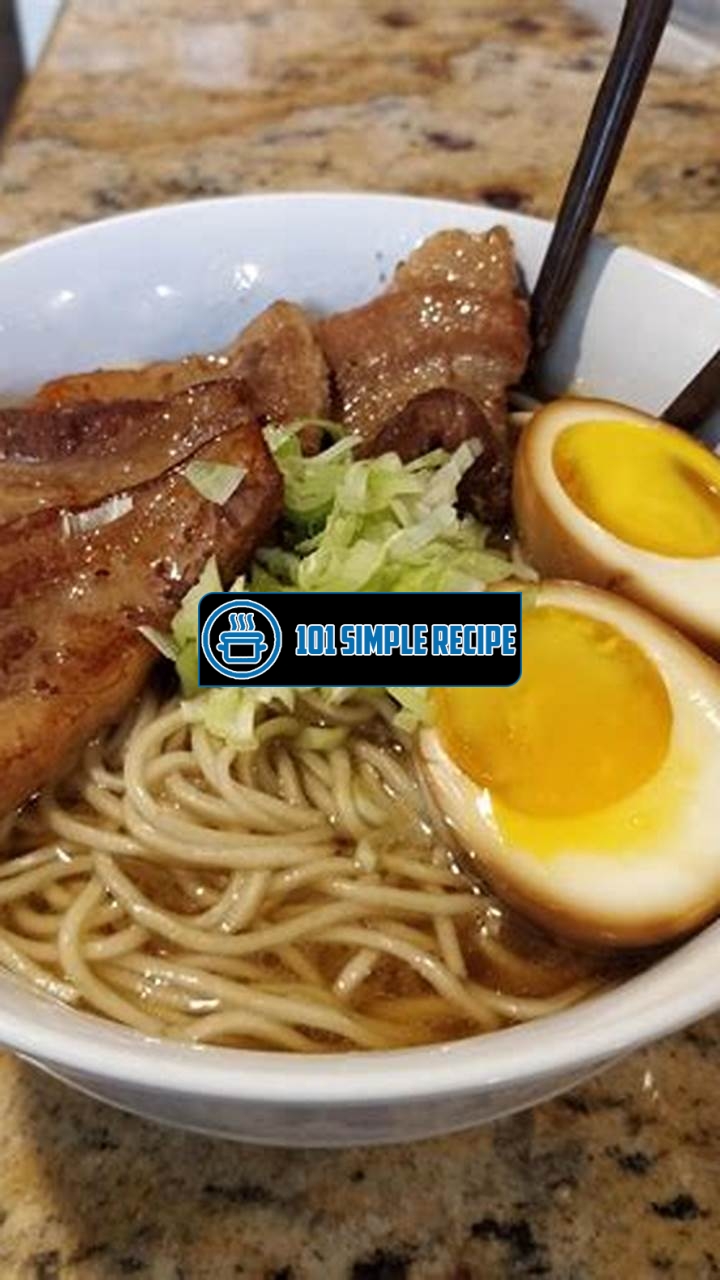Get ready to indulge in a bowl of heaven with this mouthwatering sous vide pork belly ramen. Prepared using the innovative sous vide cooking technique, the pork belly is perfectly tender and packed with flavor. Every bite will leave you craving for more! This delectable dish is served with a rich and savory broth, accompanied by springy noodles, and topped with an array of fresh and vibrant ingredients. ️ Whether you’re a ramen enthusiast or simply looking for a delightful meal, this recipe is sure to satisfy your taste buds and elevate your dining experience to new heights. So, gather your ingredients, rev up your appetite, and let’s dive into the world of delicious sous vide pork belly ramen!

Exploring the World of Sous Vide Pork Belly Ramen
Delve into the details of sous vide pork belly ramen and discover the ultimate guide to creating this flavorful dish. Whether you’re a seasoned chef or an enthusiastic home cook, this article will provide you with all the information you need to master the art of sous vide pork belly ramen.
Understanding Sous Vide Cooking
When it comes to cooking sous vide, precision is key. The technique involves sealing the ingredients in a vacuum-sealed bag and then immersing them in a water bath heated to a specific temperature. This gentle and controlled cooking method ensures that the pork belly cooks evenly and retains its moisture.
Key point: Sous vide cooking is all about precision and maintaining the perfect temperature to achieve tender and succulent pork belly.
Choosing the Perfect Pork Belly
The quality of the pork belly is crucial for a delicious ramen dish. Look for cuts with a good balance of fat and meat, as the fat adds flavor and juiciness to the dish. Opt for pork belly with even marbling and a thick layer of fat, as this will result in a melt-in-your-mouth texture.
Key point: Choosing high-quality pork belly with a good fat-to-meat ratio ensures a rich and flavorful ramen experience.
The Art of Marinating and Seasoning
Marinating and seasoning the pork belly is an essential step in enhancing its taste. A popular marinade for sous vide pork belly ramen includes soy sauce, mirin, garlic, ginger, and other flavorful ingredients. Allow the pork belly to marinate overnight or for a few hours to infuse it with the delicious flavors.
Key point: The marinade is the secret behind the mouthwatering flavors of the sous vide pork belly ramen. Take your time to let the pork belly soak in the marinade to achieve maximum taste.
In conclusion, exploring the world of sous vide pork belly ramen opens up a world of flavors and techniques. Understanding sous vide cooking, selecting the perfect pork belly, and mastering the art of marinating and seasoning are key components to creating a truly delicious dish. Get ready to impress your friends and family with this restaurant-quality ramen at home.
If you’re looking for a delicious ramen recipe, you might also enjoy our sous vide pork belly ramen recipe! It’s a flavorful and comforting dish that you won’t want to miss.
The Sous Vide Process: From Preparation to Cooking
Are you ready to embark on a culinary adventure with the mouthwatering flavors of sous vide pork belly ramen? In this article, we will guide you through the step-by-step process of preparing and cooking sous vide pork belly to perfection. From prepping the pork belly to sealing and immersing it in the water bath, we’ve got you covered.
Prepping the Pork Belly
Before diving into the sous vide cooking process, it is crucial to properly prepare the pork belly. Start by ensuring that the pork belly is fresh and of high quality. Look for a piece that is well-marbled with fat, as this will contribute to its tenderness and flavor.
Next, season the pork belly with your favorite flavors and spices. You can opt for a classic combination of salt and pepper or get creative with herbs, spices, and marinades. The choice is yours, but make sure to evenly coat the pork belly for a balanced flavor profile.
Once seasoned, it’s time to vacuum-seal the pork belly. This step helps lock in the flavors and juices, ensuring a succulent end result. Place the seasoned pork belly in a vacuum-sealable bag, removing as much air as possible before sealing it tightly. This will prevent any water from seeping into the bag during the cooking process.
Temperature and Timing for Sous Vide Cooking
Now that the pork belly is prepped and ready, it’s time to focus on the temperature and timing for sous vide cooking. Sous vide relies on precise temperature control to achieve optimal results. For pork belly, a temperature of around 165°F (74°C) works wonders.
However, it is essential to consider the desired texture when determining the cooking time. For a melt-in-your-mouth tenderness, a cooking time of 10 to 12 hours at 165°F (74°C) is recommended. This slow cooking method allows the pork belly to become incredibly tender while retaining its delicious flavors.
During the cooking process, it may be tempting to open the water bath and check on the progress. However, it is best to resist the temptation as maintaining a consistent temperature is crucial for sous vide cooking. Trust the process and let the magic happen.
Sealing and Immersion in the Water Bath
With the pork belly prepped and the temperature set, it’s time to seal the bag and immerse it in the water bath. Ensure that the vacuum-sealed bag is fully submerged in the water bath, allowing for even heat distribution.
As the pork belly cooks in the water bath, the flavors will intensify, and the fat will render, resulting in a tender and succulent texture. The sous vide method ensures that the pork belly retains its moisture, resulting in a dish that is bursting with flavor.
After the recommended cooking time has elapsed, carefully remove the bag from the water bath. Be cautious when opening the bag, as there may be hot steam released. Once opened, you will be greeted with the aroma of perfectly cooked sous vide pork belly.
Now that you have uncovered the step-by-step process of preparing and cooking sous vide pork belly, it’s time to unleash your culinary skills and indulge in a bowl of delicious ramen. Whether you’re a seasoned chef or an aspiring home cook, this recipe is sure to impress your taste buds.
Note: Emphasize the importance of following food safety guidelines, including properly storing and reheating leftover pork belly.
If you’re interested in losing weight, be sure to try our weight loss recipe. It’s packed with nutritious ingredients and delicious flavors to help you reach your goals.
Creating the Ultimate Ramen Broth
When it comes to creating the ultimate ramen broth for your sous vide pork belly ramen, it’s all about crafting a rich and flavorful base that will perfectly complement the other ingredients in your bowl. The broth sets the foundation for the entire dish, and getting it right is essential for a truly satisfying ramen experience.
To begin, let’s explore the different varieties of traditional ramen broth that you can draw inspiration from. Traditional ramen broths can be categorized into four main types: shoyu, shio, miso, and tonkotsu. Each variety has its own distinct flavor profile and ingredients, allowing you to choose the one that best suits your preferences.
Shoyu broth is soy sauce-based and has a salty and savory flavor. It is often made with chicken or vegetable stock, soy sauce, and a variety of aromatics such as garlic and ginger.
Shio broth, on the other hand, is a salt-based broth that is known for its light and delicate flavors. It is typically made with a combination of chicken or vegetable stock, salt, and various seasonings like seaweed and dried fish.
Miso broth is made from fermented soybean paste and has a rich and savory taste. It is usually combined with chicken or vegetable stock, miso paste, and other umami-rich ingredients like mushrooms and seaweed.
Tonkotsu broth is a pork bone-based broth that is known for its creamy and rich consistency. It requires hours of simmering pork bones to extract all the flavors and create a thick, collagen-filled broth.
Now that you’re familiar with the traditional ramen broth varieties, let’s move on to the secret ingredients that can take your broth to the next level. One essential ingredient is kombu, a type of dried kelp that adds a deep umami flavor to the broth. Another secret ingredient is bonito flakes, which are dried, fermented, and smoked skipjack tuna. These flakes bring a smoky and savory taste to the broth.
In addition to these secret ingredients, there are a few simmering techniques that you can employ to enhance the depth of flavor in your broth. One technique is double boiling, where you simmer the broth in a pot nestled within another pot of boiling water. This method ensures a slow and steady simmer, resulting in a more concentrated and flavorful broth. Another technique is skimming the broth during the simmering process to remove any impurities and fat that may cloud the flavor.
By combining the right broth variety, secret ingredients, and simmering techniques, you can create a truly unforgettable ramen broth that will elevate your sous vide pork belly ramen to new heights. Experiment with different flavors and find what works best for you. Happy cooking!
Enhancing Your Ramen Bowl with Toppings and Garnishes
Discover the art of topping your sous vide pork belly ramen with a variety of flavorful ingredients to elevate its taste and presentation.
Traditional Ramen Toppings
When it comes to traditional ramen toppings, there are several classic ingredients that can enhance the flavor and texture of your sous vide pork belly ramen. These traditional toppings include:
- Nori: Nori, which is dried seaweed, adds a subtle oceanic flavor to your ramen broth. It not only enhances the taste but also provides a beautiful green color that adds to the aesthetic appeal of the dish.
- Soft-Boiled Egg: A perfectly cooked soft-boiled egg adds richness to your ramen bowl. The creamy yolk creates a velvety texture that complements the tender and juicy pork belly.
- Scallions: Scallions, or green onions, bring a refreshing and slightly tangy taste to the ramen. They also provide a pop of color that brightens up the overall presentation of the dish.
- Bamboo Shoots: Bamboo shoots add a unique crunch to your ramen. They have a mild flavor that pairs well with the rich and savory broth.
- Mushrooms: Whether it’s shiitake, enoki, or oyster mushrooms, adding these earthy fungi to your ramen creates a delightful umami flavor. They also add a chewy texture that complements the pork belly.
Experimental Garnishes for Unique Flair
If you’re feeling adventurous, you can experiment with unconventional garnishes to give your sous vide pork belly ramen a unique flair. These experimental garnishes can take your ramen experience to the next level:
- Spicy Mayo: Add a kick of heat to your ramen by drizzling some spicy mayo on top. The creamy and spicy combination adds a burst of flavor that tantalizes your taste buds.
- Tempura: Tempura-battered ingredients like shrimp or vegetables add a delightful crunch to your ramen. The contrast between the crispy coating and the tender pork belly creates a satisfying texture.
- Pickled Vegetables: Pickles add acidity and tang to your ramen bowl. Whether it’s pickled ginger, radish, or cucumber, these tangy additions provide a refreshing counterpoint to the richness of the pork belly.
- Seared Garlic: Sliced garlic seared in a hot pan until golden brown adds a nutty and caramelized flavor to your ramen. It adds depth and complexity to the overall taste profile.
- Corn: Sweet corn kernels add a burst of sweetness to your ramen. They provide a pleasant contrast to the savory and rich flavors of the broth and pork belly.
The Art of Plating Ramen
Plating ramen is not just about taste; it’s also about presentation. To master the art of plating your sous vide pork belly ramen, follow these tips:
- Bowl Selection: Choose a bowl that complements the colors of your ramen ingredients. A neutral or earthy-toned bowl allows the vibrant colors of the toppings to shine.
- Arrangement: Arrange your toppings in a visually pleasing way. Create balance by distributing the ingredients evenly throughout the bowl and placing contrasting colors and textures next to each other for an eye-catching presentation.
- Garnish Placement: Place your garnishes strategically. Sprinkle chopped scallions or nori on top for added color and texture. Drizzle sauces or oils in a spiral pattern or zigzag motion for a visually stunning effect.
- Final Touches: Before serving, wipe the edges of the bowl clean to ensure a tidy presentation. Add a final sprinkle of sesame seeds or a dash of chili flakes for an extra touch of flavor and visual appeal.
With these tips and ideas in mind, you can take your sous vide pork belly ramen to new heights by experimenting with traditional toppings, trying out unique garnishes, and mastering the art of plating. So go ahead and create a bowl that not only delights your taste buds but also captivates your eyes.
For more mouthwatering recipes, check out our 101 Simple Recipes website. You’ll find a wide variety of dishes to satisfy your cravings.
Perfecting the Ramen Eating Experience
When it comes to enjoying a delicious bowl of sous vide pork belly ramen, it’s important to learn the proper techniques and etiquette to truly savor its flavors. Follow these tips to elevate your ramen eating experience:
Mastering Chopstick Skills
To fully appreciate the textures and flavors of the ramen, it’s essential to master the art of using chopsticks. Proper finger placement is crucial, ensuring a secure grip on the chopsticks. Hold one chopstick between your thumb and middle finger, resting it on your ring finger. Use your index finger to hold the other chopstick and control its movement.
Practice the gentle movements of picking up the ramen noodles and other ingredients without dropping them. Start by using the chopsticks to gently lift a few strands of noodles from the bowl. Bring the noodles close to your mouth and slurp them in. Slurping not only enhances the taste, but it also helps cool down the hot noodles, allowing you to fully enjoy their flavors without burning your tongue.
Remember, using chopsticks is an important part of the ramen experience, so keep practicing until you feel comfortable and confident.
In addition to chopsticks, a ramen spoon is often provided to enjoy the rich broth that accompanies the noodles. The spoon allows you to scoop up the flavorful liquid and savor it between bites of noodles and other toppings.
To navigate the ramen spoon with ease, hold it in your dominant hand and use it to scoop up some broth along with a few noodles. Bring the spoon to your mouth and sip the broth, savoring its rich flavors. As with the chopsticks, don’t be afraid to slurp the broth to fully enjoy its taste.
Remember, the spoon is your ally in experiencing the full depth of flavors in each spoonful of ramen. Use it to your advantage and savor every drop of the delicious broth.
The Art of Slurping
When it comes to enjoying ramen, slurping is not only acceptable but encouraged. Slurping noodles not only enhances the overall taste experience, but it also allows you to cool down the hot noodles as you consume them. The act of slurping aerates the noodles, releasing their flavors and aroma.
Slurping is considered a sign of appreciation in many Asian cultures and shows that you are thoroughly enjoying your meal. So, don’t be shy about slurping your sous vide pork belly ramen. Embrace the art of slurping and let the flavors dance on your palate.
To summarise, mastering the art of using chopsticks and the ramen spoon, as well as embracing the art of slurping, are key elements in perfecting the ramen eating experience. By following these techniques and etiquette, you can truly savor the intricate flavors of sous vide pork belly ramen and elevate your dining experience.
Thanks for taking the time to read our article on sous vide pork belly ramen! We hope you found it informative and inspiring for your next cooking adventure. If you’re craving a melt-in-your-mouth pork belly with perfectly tender noodles, make sure to bookmark this page and visit us again for more delicious recipes.
Frequently Asked Questions
Here are some common questions about sous vide pork belly ramen:
| No. | Questions | Answers |
|---|---|---|
| 1. | What is sous vide cooking? | Sous vide is a cooking technique that involves vacuum-sealing food in a plastic bag and cooking it in a temperature-controlled water bath for an extended period. It results in tender and flavorful dishes. |
| 2. | Can I use regular pork belly for this recipe? | Yes, you can use regular pork belly instead of sous vide pork belly. However, sous vide pork belly offers a more tender and consistent texture. |
| 3. | What noodles are best for ramen? | Traditional ramen noodles are made from wheat flour. Look for fresh or dried ramen noodles in Asian grocery stores for an authentic experience. |
| 4. | Can I customize the toppings? | Absolutely! Ramen is highly customizable. Feel free to add or remove toppings based on your preferences. Some popular options include green onions, soft-boiled eggs, bamboo shoots, and seaweed. |
| 5. | How long does it take to cook sous vide pork belly? | The cooking time can vary depending on the thickness of the pork belly. However, a common guideline is to cook it at 167°F (75°C) for 12-24 hours. |
| 6. | Can I freeze the leftover ramen? | While it’s best to enjoy ramen fresh, you can freeze leftovers. Just make sure to store the broth and toppings separately and thaw them properly before reheating. |
Come back for more culinary delights!
We appreciate you reading our article on sous vide pork belly ramen. If you’re hungry for more exciting recipes and culinary adventures, remember to visit our website regularly. Happy cooking!
Jump to Recipe
Sous Vide Pork Belly Ramen

Indulge in the perfect combination of tender sous vide pork belly and flavorful ramen noodles with this delicious recipe. It’s a bowl of comfort that will satisfy your cravings.
- 1.5 lb 680g pork belly
- 1 tsp salt
- 1 tsp black pepper
- 4 cloves garlic (minced)
- 2 tbsp soy sauce
- 2 tbsp mirin
- 2 tbsp sake
- 4 cups chicken broth
- 4 eggs
- 8 oz 227g ramen noodles
- 4 green onions (chopped)
- 2 sheets nori (cut into small rectangles)
- Season the pork belly with salt and black pepper. Place it in a vacuum-sealed bag and add minced garlic, soy sauce, mirin, and sake. Vacuum-seal the bag using a sous vide machine.
- Preheat the sous vide water bath to 167°F (75°C). Place the vacuum-sealed pork belly in the water bath and cook for 12-24 hours.
- In a separate pot, bring water to a boil and cook the ramen noodles according to the package instructions. Drain and set aside.
- Bring a small pot of water to a boil. Gently lower the eggs into the boiling water and cook for 6 minutes. Transfer the eggs to an ice bath, then peel and set aside.
- Divide the cooked ramen noodles among four bowls. Slice the sous vide pork belly into thin slices and place on top of the noodles. Pour hot chicken broth into each bowl. Garnish with soft-boiled eggs, chopped green onions, and nori. Serve immediately.
- Grab your chopsticks and savor every bite of this delectable sous vide pork belly ramen. It’s a dish that combines melt-in-your-mouth pork belly with rich, flavorful broth and toothsome noodles.






